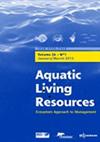Review of the current situation, problems, and challenges in fish seed production and supply for Bangladesh's aquaculture development
IF 1.9
4区 农林科学
Q3 FISHERIES
引用次数: 0
Abstract
Fish seed are important for the growth of aquaculture in Bangladesh, but there are many challenges associated with supplying quality fish seed. This review evaluated the current level of production, issues and challenges that are affecting the production of fish seed in Bangladesh. The fish hatchery was found to be the major contributor in terms of fish seed production. Out of 671 metric tons of fish seed produced in 2020–2021, above 99% were from hatcheries. Freshwater finfish hatcheries have expanded over the last 30 yr, and are distributed throughout the country, but there is no commercial hatchery for coastal and marine water finfish species in the country. Shrimp and prawn hatcheries are concentrated in Cox's Bazar and the greater Jassore regions, respectively, while crab culture is entirely dependent on wild capture. Crablets are collected from nature, which has a devastating impact on biodiversity and wild stocks. The fish seed value chain is multidirectional and interlinked, and intermediaries dominate the supply chain. Disease outbreaks and indiscriminate use of chemicals are major concerns in fish seed production. Management strategies such as the introduction of certification, training programs, technology transfer, access to credit, and implementation of the law could improve the quality and productivity of fish seed in Bangladesh.
回顾了孟加拉国水产养殖发展中鱼类种子生产和供应的现状、问题和挑战
鱼籽对孟加拉国水产养殖的发展很重要,但在供应优质鱼籽方面存在许多挑战。本次审查评估了孟加拉国目前的生产水平、影响鱼籽生产的问题和挑战。鱼类孵化场被认为是鱼类种子产量的主要贡献者。在2020-2021年生产的671公吨鱼籽中,99%以上来自孵化场。淡水鳍鱼孵化场在过去30年中不断扩大,分布在全国各地,但该国没有沿海和海水鳍鱼的商业孵化场。虾和对虾孵化场分别集中在考克斯巴扎尔和大贾索尔地区,而螃蟹养殖完全依赖于野生捕捞。从自然界采集的螃蟹对生物多样性和野生种群造成了毁灭性的影响。鱼籽价值链是多向、联动的,中介机构在供应链中占主导地位。疾病爆发和滥用化学品是鱼类种子生产中的主要问题。诸如引入认证、培训计划、技术转让、获得信贷和实施法律等管理战略可以提高孟加拉国鱼籽的质量和生产力。
本文章由计算机程序翻译,如有差异,请以英文原文为准。
求助全文
约1分钟内获得全文
求助全文
来源期刊

Aquatic Living Resources
农林科学-海洋与淡水生物学
CiteScore
2.30
自引率
0.00%
发文量
10
审稿时长
>24 weeks
期刊介绍:
Aquatic Living Resources publishes original research papers, review articles and propective notes dealing with all exploited (i.e. fished or farmed) living resources in marine, brackish and freshwater environments.
Priority is given to ecosystem-based approaches to the study of fishery and aquaculture social-ecological systems, including biological, ecological, economic and social dimensions.
Research on the development of interdisciplinary methods and tools which can usefully support the design, implementation and evaluation of alternative management strategies for fisheries and/or aquaculture systems at different scales is particularly welcome by the journal. This includes the exploration of scenarios and strategies for the conservation of aquatic biodiversity and research relating to the development of integrated assessment approaches aimed at ensuring sustainable and high quality uses of aquatic living resources.
 求助内容:
求助内容: 应助结果提醒方式:
应助结果提醒方式:


